by Patrick Roefflaer
- Released June 20, 1980
- Pastel Tony Wright
- Photographer Arthur Rosato
- Art-director Tony Wright
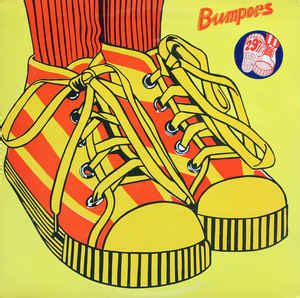 At the end of the sixties, British record labels experimented with samplers: double albums with an eclectic selection of songs by artists from their range. Because the whole thing is offered at a low price, the compilations prove to be very popular – especially with teenagers on a budget. For the record company, it’s an interesting way to introduce the listener to a large number of their artists. Of course, the cover should not cost too much.
At the end of the sixties, British record labels experimented with samplers: double albums with an eclectic selection of songs by artists from their range. Because the whole thing is offered at a low price, the compilations prove to be very popular – especially with teenagers on a budget. For the record company, it’s an interesting way to introduce the listener to a large number of their artists. Of course, the cover should not cost too much.
While visiting a poster shop in London’s Kings Road, Chris Blackwell of Island Records finds a solution. He sees a poster on which the same pair of sports shoes is depicted nine times, each time in a different colour. The screen print is the work of a 19-year-old: Tony Wright. Blackwell pays Wright £200 for the rights, and buys all available copies of the poster.
The shoes on the poster are called Bumpers and that naturally becomes the name of the album.
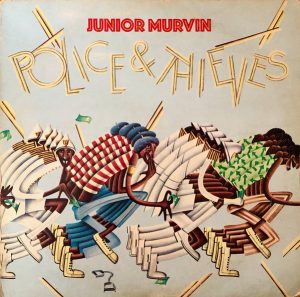 In addition, Blackwell offers the young man a job: design record covers for Island Records. His first major cover is one for Traffic (The Low Spark of High Heeled Boys), followed by Bob Marley (Natty Dread) and numerous reggae records, such as Police and Thieves (Junior Murvin), Super Ape (Lee Perry) and War Ina Babylon (Max Romeo).
In addition, Blackwell offers the young man a job: design record covers for Island Records. His first major cover is one for Traffic (The Low Spark of High Heeled Boys), followed by Bob Marley (Natty Dread) and numerous reggae records, such as Police and Thieves (Junior Murvin), Super Ape (Lee Perry) and War Ina Babylon (Max Romeo).
At the end of 1979 Wright was allowed to move to New York to become head of the American branch of the record company. The job includes an apartment on the 47th floor of a building on 57th Street, with a “view like a God of Central Park and New York,” as he puts it. “On a stormy day, the clouds passed under my window. I was in the middle of New York, but I wasn’t exactly ‘in’ New York.”
In the last days of February 1980, Wright is barely in New York for a few months, when he unexpectedly receives a call from Jerry Wexler. Wright has met the producer a few times and the man knows his job. Wexler asks him about his religious beliefs and states that he can expect a phone call from someone. That’s all he wants to say.
What follows is based on the story as Tony Wright noted it for David Eckstrom in January 2016. Eckstrom is the owner of forever young records in Texas, and prides himself on owning the largest collection of Dylan material. In 2016, he bought the original design of the cover and asked Wright to explain how it was created. Wright gave me permission to display his story here and also to use the images.
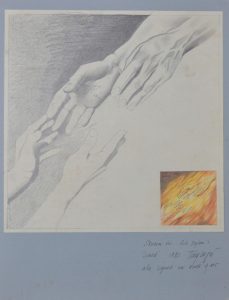 “A few minutes later, Bob Dylan was on the line. Wexler had just finished the record [Saved] and Bob was looking in vain for an artist who could visualize his dream, a vision he had experienced, for the cover.
“A few minutes later, Bob Dylan was on the line. Wexler had just finished the record [Saved] and Bob was looking in vain for an artist who could visualize his dream, a vision he had experienced, for the cover.
Dylan told me that he had seen my work and knew that I had the technical expertise, but that he needed someone who understood him. I could only say: Tell me what you want.
That was a vision, a kind of whole apparently, including all the songs from the record. The image was the hand of God/Christ reaching down to the hands of men. I asked: Rich from heaven? “No, not from heaven. Through it, like through oil.’
No problem: I understand. That same day, I sent him a sketch.
He called me again, completely over the moon. “How did you do that? It’s exactly what I wanted. That’s him. That’s the cover. It will certainly win an award.’
I replied: No, that’s a sketch. You can’t use that. I’ll take the plane and come and discuss the final version with you. “Oh, okay.”
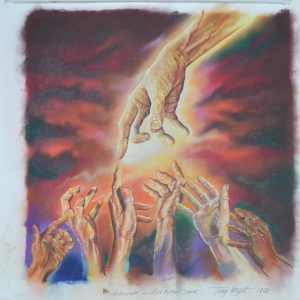 The next day I arrived in LA, with a box full of pastels and paper. I took a taxi to Santa Monica, where he had a rehearsal room with office. As I walked up the stairs from the front desk, I saw him. He stood on the lookout in a small back room, to see what kind of person was coming. In the classroom there was a refrigerator, a small, much too fat dog – a Basset dog, I think – and a blackboard. It quickly became clear to me why the dog was overweight, when I noticed how Bob regularly went into the fridge to get some treats for him.
The next day I arrived in LA, with a box full of pastels and paper. I took a taxi to Santa Monica, where he had a rehearsal room with office. As I walked up the stairs from the front desk, I saw him. He stood on the lookout in a small back room, to see what kind of person was coming. In the classroom there was a refrigerator, a small, much too fat dog – a Basset dog, I think – and a blackboard. It quickly became clear to me why the dog was overweight, when I noticed how Bob regularly went into the fridge to get some treats for him.
He gave me a tour and explained that the band was rehearsing here and that he was the singer. It seems like an absurd addition, but it proves that Bob Dylan doesn’t take it for granted that everyone knows who he is.
We sat down, talked a bit and it clicked. He wanted to add some blood to the hand on the sketch, so I took my pastel and drew some blood smoothly over the hand. “Wow, Tony. I’ve never seen an artist at work before.’
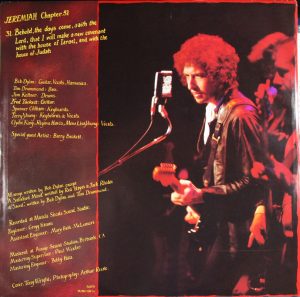 When we were done, we agreed that I would go on tour to take some pictures and finish the corner drawing. It was an absurd dream for a Bob Dylan fan. I had first seen him at the Royal Albert Hall in 1965 – I was truant from school before – and the last time was at Earls Court in London (June 1978). Then you only saw a speck of light in the distance, in which you could suspect Bob Dylan. Now, however, I had a backstage pass and could go wherever I wanted: in the audience, backstage or even, at Bob’s own request, on stage to take pictures.
When we were done, we agreed that I would go on tour to take some pictures and finish the corner drawing. It was an absurd dream for a Bob Dylan fan. I had first seen him at the Royal Albert Hall in 1965 – I was truant from school before – and the last time was at Earls Court in London (June 1978). Then you only saw a speck of light in the distance, in which you could suspect Bob Dylan. Now, however, I had a backstage pass and could go wherever I wanted: in the audience, backstage or even, at Bob’s own request, on stage to take pictures.
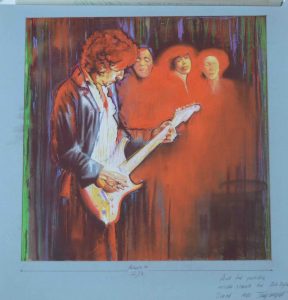 I travelled back and forth to NY over and over again, for each gig, and then arrived sometime in the late afternoon, just in time for the soundcheck. Imagine standing on an empty stage, while Bob Dylan sings ‘Pressing On’ on his own at the piano. The morning [after the performance] we discussed the progress in his hotel room. Bob is very talkative, as long as you don’t talk about the subject of ‘Bob Dylan’. I instinctively sensed that and we even talked about Bob Dylan in the third person. He is interested in art. We talked about it a lot. Ordinary conversations with an ordinary guy, who happens to be a genius when he practices his profession.”
I travelled back and forth to NY over and over again, for each gig, and then arrived sometime in the late afternoon, just in time for the soundcheck. Imagine standing on an empty stage, while Bob Dylan sings ‘Pressing On’ on his own at the piano. The morning [after the performance] we discussed the progress in his hotel room. Bob is very talkative, as long as you don’t talk about the subject of ‘Bob Dylan’. I instinctively sensed that and we even talked about Bob Dylan in the third person. He is interested in art. We talked about it a lot. Ordinary conversations with an ordinary guy, who happens to be a genius when he practices his profession.”
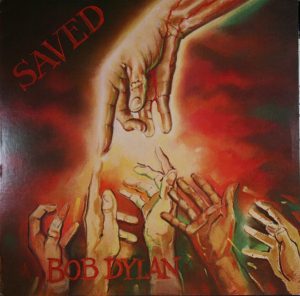 In addition to the pastel with the hands, Wright submits two pastel drawings for the inner cover: both are based on photos he took during live performances of the gospel tour.
In addition to the pastel with the hands, Wright submits two pastel drawings for the inner cover: both are based on photos he took during live performances of the gospel tour.
Also, there are also two photos of Arthur Rosato, taken during the same tour.However, the record company is not happy with the new direction that Dylan has taken. The attitude is downright hostile. “When the record was finished, they were so rude, so mean about Bob Dylan…
 They said they wouldn’t do any promotion for this record – another religious record. […]
They said they wouldn’t do any promotion for this record – another religious record. […]
I heard how those people, the seniors at CBS, talked about him as if… ‘He can go up the tree’. Something like that.”
They also didn’t like the proposed cover. “I think it goes heavily against Jewish sensibilities.”
Alternative artwork
 As soon as the record company gets the chance, they replace the cover with one of Wright’s other pastels, on which Dylan plays harmonica on stage.
As soon as the record company gets the chance, they replace the cover with one of Wright’s other pastels, on which Dylan plays harmonica on stage.
That happens sometime in 1985, for the covers of the vinyl records in the United States and Spain. “They’ve always hated it,” Tony Wright said. “Really hated. They were waiting for it.”
Even when Saved is later released on CD, the distinction remains: while in the rest of the world the original cover is usually retained, in the United States the modified version is used. Only in November 2013, with the box set The Complete Album Collection Vol. One, the CD appears for the first time with the original cover.
Here are the articles so far in this series. All are by Patrick Roefflaer.
- Another side of Bob Dylan
- Biograph – see Empire Burlesque
- Blonde On Blonde: The Artwork
- Blood on the Tracks
- Bob Dylan
- Bob Dylan’s Greatest Hits
- Bringing it All Back Home
- Desire
- Down in the Groove
- Dylan
- Empire Burlesque and Biograph artwork
- Good as I’ve been to you
- Greatest Hits Volume II
- Highway 61 Revisited
- Infidels: what’s in a name?
- John Wesley Harding: the art work
- Knocked Out Loaded
- Love and Theft
- Nashville Skyline
- New Morning
- Oh Mercy
- Pat Garrett and Billy the Kid
- Self-Portrait
- Shot of Love
- Slow Train Coming
- Street Legal and the secret cover location
- The Basement Tapes
- The Freewheelin’ Bob Dylan – the untold story of the artwork of the album
- The Times they are a changin’ album artwork
- Time out of Mind
- Travelling Wilburys Vol 1 (guest visitor, Michael Palin)
- Triplicate
- World Gone Wrong

Talking of Michelangelo
Reminds of a close up of “The Creation of Adam” by Michelangelo with the suggestion of a Jesus figure from above instead of God
On the original cover, a hand on the bottom left is removed ….to show 5 instead of 6
Thank you. I love these stories about the album covers.